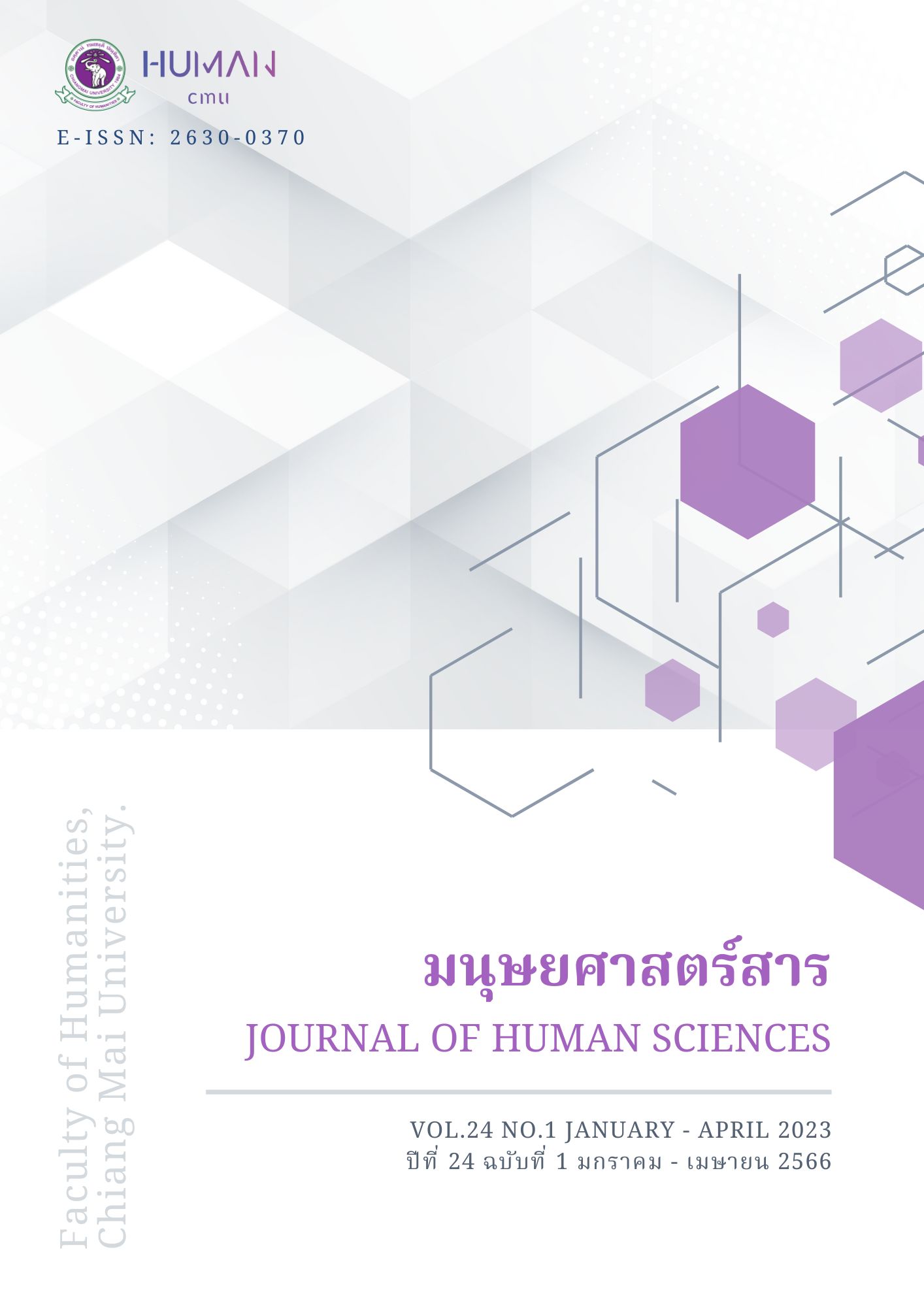สงคราม (โรค) โควิด 19: อุปลักษณ์เชิงมโนทัศน์ของสังคมไทยและโลก ที่สะท้อนผ่านหนังสือพิมพ์ไทยออนไลน์
Main Article Content
บทคัดย่อ
งานวิจัยนี้มีวัตถุประสงค์เพื่อศึกษาถ้อยคำอุปลักษณ์ที่สะท้อนอุปลักษณ์เชิงมโนทัศน์ [โควิด คือ สงคราม] และวิเคราะห์หน้าที่ของอุปลักษณ์เชิงมโนทัศน์ [โควิด คือ สงคราม] ในหนังสือพิมพ์ไทยออนไลน์
ตามแนวภาษาศาสตร์ปริชานและวัจนปฏิบัติศาสตร์ โดยเก็บข้อมูลจากเว็บไซต์หนังสือพิมพ์ไทยที่เผยแพร่ออนไลน์ระหว่างเดือนมกราคม พ.ศ. 2563 – มิถุนายน พ.ศ. 2564 ซึ่งเป็นช่วงที่มีการแพร่ระบาดของ
โรคติดเชื้อไวรัสโคโรนา 2019 หรือโควิด 19 ผลการศึกษาพบถ้อยคำอุปลักษณ์ที่เปรียบเทียบโควิดคือสงคราม จำนวน 162 คำ ถ้อยคำอุปลักษณ์เหล่านี้สะท้อนให้เห็นว่า การแก้ไขปัญหาการแพร่ระบาดของเชื้อไวรัสโคโรนา 2019 เป็นการทำสงคราม สามารถจำแนกได้เป็น 8 กลุ่มความหมาย อุปลักษณ์ดังกล่าวทำหน้าที่ 3 ด้าน คือ
(1) หน้าที่ด้านการถ่ายทอดความคิด (2) หน้าที่ด้านบุคคลสัมพันธ์ และ (3) หน้าที่ด้านการเรียบเรียงความ
อุปลักษณ์นี้สะท้อนให้เห็นมโนทัศน์หลายประการ เช่น การแพร่ระบาดของโควิด 19 คือ การรุกราน โควิด 19 เป็นภัยอันตรายของมนุษย์ซึ่งต้องกำจัดให้หมดไป และแพทย์ บุคลากรทางการแพทย์ และวัคซีนคือที่พึ่ง
Article Details

อนุญาตภายใต้เงื่อนไข Creative Commons Attribution-NonCommercial-NoDerivatives 4.0 International License.
เอกสารอ้างอิง
ภาษาไทย
กนกกาญจน์ วรสีหะ (2555). “การชุมนุมทางการเมืองคือการทำสงคราม” มโนทัศน์ที่สะท้อนจากอุปลักษณ์ข่าว
การชุมนุมทางการเมืองจากหนังสือพิมพ์ไทย. วารสารสถาบันวัฒนธรรมและศิลปะ มหาวิทยาลัย
ศรีนครินทรวิโรฒ, 13(2), 49-55.
จิตติมา จารยะพันธุ์. (2539). อุปลักษณ์สงครามในข่าวกีฬาในหนังสือพิมพ์ภาษาไทย [วิทยานิพนธ์ปริญญา
มหาบัณฑิต, จุฬาลงกรณ์มหาวิทยาลัย]. Digital Research Information Center.
https://dric.nrct.go.th/index.php?/Search/SearchDetail/71746
ซิน เซี่ย และ ดีอนา คาซา (2565). การศึกษาเปรียบเทียบถ้อยคำในการประชาสัมพันธ์เพื่อเชิญชวนป้องกัน
โควิด-19 ระหว่างสาธารณรัฐประชาชนจีนกับประเทศไทย. วารสารวิชาการ มหาวิทยาลัยหอการค้าไทย มนุษยศาสตร์และสังคมศาสตร์, 42(2), 36-50.
ณัฐพร พานโพธิ์ทอง. (2556). วาทกรรมวิเคราะห์เชิงวิพากษ์ตามแนวภาษาศาสตร์: แนวคิดและการนำมา
ศึกษาวาทกรรมในภาษาไทย. โครงการเผยแพร่ผลงานวิชาการ คณะอักษรศาสตร์ จุฬาลงกรณ์มหาวิทยาลัย.
ธนพล เอกพจน์, วิรัช วงศ์ภินันท์วัฒนา และ ปานปั้น ปลั่งเจริญศรี (2563). [ไวรัสโคโรนาสายพันธุ์ใหม่ 2019
คือ ศัตรูู]: การศึกษาอุุปลักษณ์เชิงมโนทัศน์ของคนไทยตามแนวภาษาศาสตร์ปริชาน. วารสารภาษา ศาสนา และวัฒนธรรม, 9(1), 1-37.
ธีระยุทธ สุริยะ. (2562). “โรฮิงญาเป็นภัยอันตราย” ภาพตัวแทนของชาวโรฮิงญาในวาทกรรมข่าว: การวิเคราะห์
อุปลักษณ์เชิงวิพากษ์. มนุษยศาสตร์วิชาการ, 26(1), 252-285.
ประกาศกระทรวงสาธารณสุขเรื่องชื่อและอาการสำคัญของโรคติดต่ออันตราย (ฉบับที่3) พ.ศ.2563. (2563,
กุมภาพันธ์). ราชกิจจานุเบกษา. เล่ม 137 ตอนพิเศษ 48 ง หน้า 1.
รัชนีย์ญา กลิ่นน้ำหอม และณัฐพร พานโพธิ์ทอง. (2551). การเมืองคือการรักษาโรค: มโนอุปลักษณ์ที่สะท้อน
จากถ้อยคำอุปลักษณ์ของนักการเมืองไทย. ภาษาและวรรณคดีไทย, 25 (2551), 132-157.
_________________. (2560) . “น้ำท่วมคือสงครามและประชาชนคือเหยื่อ” : มโนทัศน์ที่สะท้อนจากพาดหัวข่าว
ในหนังสือพิมพ์ไทย. วารสารสถาบันวัฒนธรรมและศิลปะ, 19(1), 114-125.
สำนักงานราชบัณฑิตยสภา. (ม.ป.ป.). พจนานุกรม ฉบับราชบัณฑิตยสถาน พ.ศ. 2554.
อุษา พฤฒิชัยวิบูลย์. (2544). การศึกษาอุปลักษณ์เรื่องการเมืองในภาษาไทยตามแนวอรรถศาสตร์ปริชาน
[วิทยานิพนธ์ปริญญามหาบัณฑิต, มหาวิทยาลัยธรรมศาสตร์]. TU Digital collections.
http://digital.library.tu.ac.th/tu_dc/frontend/Info/item/dc:116304
เอกพล ดวงศรี. (2561). กรรม: อุปลักษณ์เชิงมโนทัศน์ที่สะท้อนความเชื่อในสังคมไทย. วารสารวิจัยและพัฒนา
มหาวิทยาลัยราชภัฏสวนสุนันทา, 10(1), 86-102.
ภาษาต่างประเทศ
Chiang, W. and Duann, R. (2007). Conceptual metaphors for SARS:‘war’ between whom?.
Discourse & Society, 18(5), 579-602.
Erlanger, S. (2020, March 15). Europeans Erect Borders Against Coronavirus, but the Enemy Is
Already Within. The NewYork Times. https://www.nytimes.com/2020/03/15/world/
europe/coronavirus-borders-fear.html
Goatly, A. (1997). The Language of Metaphors. Routledge.
_________________. (1998). The Language of Metaphors. Routledge.
Halliday, M.A.K. (1994). An introduction to functional grammar. (2nd ed.). E. Amold.
Lakoff, G. and Johnson, M. (1980). Metaphor we live by. University of Chicago Press.
_________________. (2003). Metaphors we live by. University of Chicago Press.
Schwobel-Patel, C. (2020, April 6). We don’t need a ‘war’ against coronavirus. We need solidarity.
Aljazeera. https://www.aljazeera.com/opinions/2020/4/6/we-dont-need-a-war- against-
coronavirus-we-need-solidarity
Sun, M. (2021). A Contrastive Study of Conceptual Metaphor in Korean and Chinese News reports
about COVID-19. [Master’s Thesis, Ewha Womans University]. Dspace@EWHA.
https://dspace.ewha.ac.kr/handle/2015.oak/256673
Yao, S. (2018). อุปลักษณ์สงครามสู่ “ความฝันจีน”: มุมมองทางปริชาน. มนุษยศาสตร์สาร, 19(2), 71-101.
Yonhap News. (2021, May 27). 코로나와의 전쟁, 최전선이 위태롭다…"한달 초과근무 110시간".
Yonhap News. https://www.yna.co.kr/view/AKR20210527120900051


